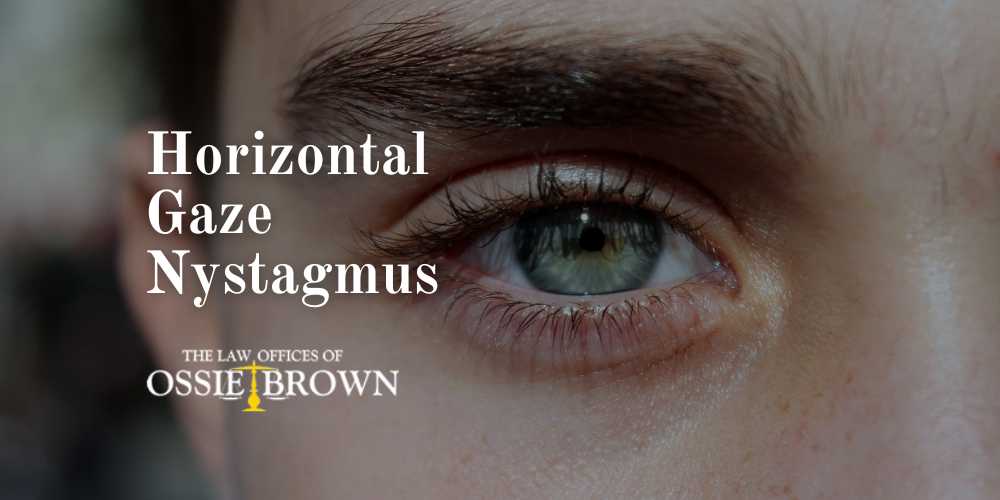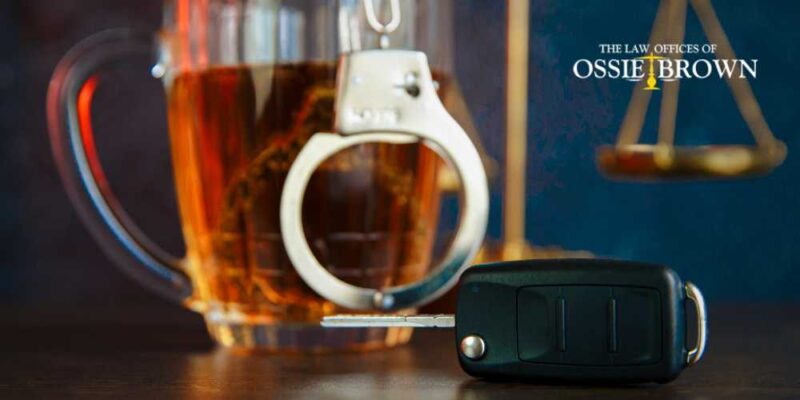If you’ve been pulled over for drunk driving in Louisiana or have been stopped at one of the many DUI checkpoints in Louisiana, one of the key tests a police officer may use to assess your level of drug or alcohol impairment is the horizontal gaze nystagmus (HGN) test.
This field sobriety testing involves tracking a person’s eyes, looking for any jerking motion that could be interpreted as a sign of drug or alcohol impairment. However, HGN evidence is not always foolproof. The horizontal gaze nystagmus (HGN) results can be influenced by factors unrelated to drug or alcohol consumption, such as a medical condition, improper administration, or even environmental factors.
Understanding how the horizontal gaze nystagmus test, as well as how other standardized field sobriety tests are used and how field sobriety testing can be challenged, is a critical part of defending against DUI charges.
At The Law Offices of Ossie Brown in Baton Rouge, we understand how critical it is to challenge the validity of standardized field sobriety tests and protect your rights if you’re facing a drunk driving conviction. Our lawyers can inform you on what to do if pulled over for DUI in Louisiana, and if you’ve failed an HGN test, our internal DUI investigations team will examine the test’s accuracy and procedural errors law enforcement officers may have made during the stop.
Call (225) 343-1111 to schedule a free consultation with a Baton Rouge attorney experienced in challenging HGN evidence in our local trial court.
What is HGN?
Horizontal gaze nystagmus (HGN) refers to the involuntary jerking of the subject’s eyes as they move to follow a smoothly moving stimulus, such as a pen/light, in the visual field. This jerking can be subtle or pronounced and is influenced by neural activity in the central nervous system. Normally, our eyes can follow a smoothly moving stimulus within our visual field with very little jerking, but drug or alcohol consumption can cause the eyes to jerk. Resting nystagmus, where the eyes jerk even when stationary, may also indicate neurological issues or intoxication. HGN can occur naturally or be caused by factors such as alcohol consumption, drug impairment, brain damage, or a medical condition.
Because of this, signs of horizontal gaze nystagmus at a particular angle are often observed by law enforcement officers during standardized field sobriety tests for DUI investigations to assess impairment levels, particularly to detect elevated blood alcohol concentration (BAC).
The police officer may note distinct and sustained nystagmus at maximum deviation during the horizontal gaze nystagmus test. This occurs when the subject’s eyes are moved as far to the side as possible (maximum deviation) while following a smoothly moving stimulus, such as a pen/light, and display:
- Distinct Nystagmus: Clear and noticeable eye jerking.
- Sustained Nystagmus: The jerking continues without stopping as the eyes remain at maximum deviation for at least four seconds.
The lack of smooth pursuit while watching a smoothly moving stimulus often indicates drug or alcohol impairment, as this makes it harder for the eyes to maintain steady movement at extreme angles. Observing this sign is one of the key signs law enforcement officers look for during DUI investigations.
What is HGN Caused by Alcohol?
HGN caused by alcohol is horizontal gaze nystagmus, which is the result of alcohol consumption. Alcohol is a central nervous system depressant and can inhibit the fine motor movements in the eye needed to pass the HGN test.
What Drugs Cause HGN?
Drugs that depress the central nervous system, such as barbiturates and sedatives, can cause horizontal gaze nystagmus. Other substances, including inhalants and some anti-seizure medications, may also lead to involuntary eye jerking during an HGN test.
If you are accused of drug impairment as a result of a failed HGN test or are accused of possessing drugs, contact our Baton Rouge drug possession attorneys today to discuss your legal options.
HGN Test Steps
The horizontal gaze nystagmus test involves a series of steps that the police officer must follow. Here’s how the process of administering these standardized field sobriety tests typically unfolds:
- The officer asks the individual to step out of the vehicle and stand in a safe, well-lit area.
- The officer explains that the HGN test involves.
- The officer ensures the individual is standing upright, with their feet together and hands at their sides, in a stable position to avoid unnecessary movement.
- The officer holds the stimulus approximately 12-15 inches from the individual’s face, at eye level. Then, the officer moves the stimulus slowly from side to side while instructing them to follow it with their eyes.
- The officer moves the stimulus repeatedly while watching each eye separately, ensuring they have an accurate view of the eye movements from start to finish.
Once the test is complete, the officer records their observations and evaluates the results alongside other standardized field sobriety tests to determine whether further action is necessary.
HGN Clues
There are a total of six clues that law enforcement officers look for, known as HGN clues.
An HGN test will look for three clues overall (six clues total, counting each eye), and police officers need to identify four or more clues during the horizontal gaze nystagmus test to deem someone intoxicated.
Involuntary Jerking and Lack of Smooth Pursuit
Before the field sobriety testing begins, the officer will look to see if the individual’s eyes have equal pupil size, equal tracking (if the eyes are both able to follow the object together), and if their eyes have any resting nystagmus. If the individual has equal pupil size and no eye jerking begins prior to the field sobriety testing, then the officer can proceed with the HGN test.
One of the three clues the officer will look for during the HGN test is eye jerking when the officer moves the stimulus or object. Normally, the subject’s eyes should move smoothly as the officer moves the pen or light track, but impairment may cause noticeable bouncing or jerk nystagmus. This lack of smooth pursuit is often one of the three clues of potential impairment detected during standardized field sobriety tests.
Distinct and Sustained Nystagmus at Maximum Deviation
The next clue occurs when a person’s eyes are moved as far to the side as possible; any sustained nystagmus that occurs is another significant clue of impairment. In this position, known as maximum deviation, the eyes should remain steady. Prolonged or distinct nystagmus at maximum deviation can indicate impairment.
Onset of Nystagmus Prior to 45 Degrees
The last clue is the onset of nystagmus prior to the eyes reaching a 45-degree angle from the center. The officer will carefully observe how soon the involuntary jerking begins as they move the stimulus to the side, in the direction of the suspect’s shoulder. Early onset of nystagmus prior to reaching this angle is often associated with higher levels of impairment and is used to estimate the degree of intoxication.
How Three-Part Standardized Field Sobriety Tests Can Affect Your Criminal Case
Standardized field sobriety tests, including the horizontal gaze nystagmus, walk-and-turn, and one-leg stand, are often used in DUI investigations under Louisiana DUI laws to assess a driver’s impairment level. These tests evaluate physical and cognitive abilities that may be impaired.
While standardized field sobriety tests are designed to estimate impairment and correlate with blood alcohol content (BAC), their reliability can be challenged. The results of these tests can significantly impact criminal cases, either supporting or weakening the prosecution’s evidence. Additionally, compliance with Louisiana liquor laws plays a key role in determining whether the driver’s BAC exceeded legal limits, which can further influence the outcome of the case.
Horizontal Gaze Nystagmus Test
The HGN eye test involves following a moving object with the eyes to detect involuntary jerking that could indicate impairment. In criminal cases, HGN test results may be used as evidence of intoxication, but improper administration or a medical condition can challenge their reliability.
Walk-and-Turn Test
The walk-and-turn test requires the individual to take a series of heel-to-toe steps in a straight line, turn, and return in the same manner. Mistakes like losing balance or stepping off the line may be presented as signs of impairment, but environmental factors or physical limitations can affect the results.
One-Leg Stand Test
In the one-leg stand test, the individual must stand on one foot while counting aloud for a specific duration. Swaying, hopping, or putting the raised foot down may be cited as evidence of alcohol impairment, though fatigue or health conditions could impact performance.
Defenses to Failed Field Sobriety Testing in Louisiana
While the horizontal gaze nystagmus test is considered a “scientific test,” it can still produce false positives, especially when affected by outside factors. In fact, the National Highway Traffic Safety Administration (NHTSA) found that it was only accurate at identifying intoxication about 77% of the time.
Some defenses to the HGN test include:
- The suspect has a medical condition such as permanent brain damage or a recent head injury, preventing their eyes from following objects in a smooth manner.
- The police officers were improperly trained and could not properly administer the test at the time.
- The suspect’s blood alcohol concentration was rising during their field sobriety test, meaning they were likely not legally intoxicated while driving, according to the rising blood alcohol defense in Louisiana.
- The suspect was physically exhausted or stressed, impacting their ability to perform the test accurately.
- The police officer’s subjective interpretation of the eye movements may not be consistent or supported by other evidence.
- Environmental factors may have impacted the test, such as patrol lights, nearby cars, other officers, or other individuals.
Our Baton Rouge DUI attorneys can use these defenses, in conjunction with expert testimony and direct evidence, to help prove your innocence in front of a trial judge. Even if found guilty, we may be able to appeal your case to a superior court in certain situations.
How Our Baton Rouge DUI Defense Lawyers Can Help
Facing drunk driving charges in Louisiana can feel overwhelming, especially when evidence like the horizontal gaze nystagmus test is presented against you. If you need a criminal defense attorney in Baton Rouge, our lawyers are dedicated to protecting your rights, even in the face of HGN evidence.
We thoroughly investigate every aspect of your case, including whether the HGN test was conducted properly and if external factors may have influenced the results. We know how to scrutinize police officer procedures to determine whether the evidence against you is credible and admissible in court. If mistakes were made during your field sobriety tests, we’ll work to have that evidence challenged or dismissed in trial court.
Call (225) 343-1111 or fill out our online contact form to schedule a free consultation and learn how a lawyer can help with a DUI in Louisiana.




